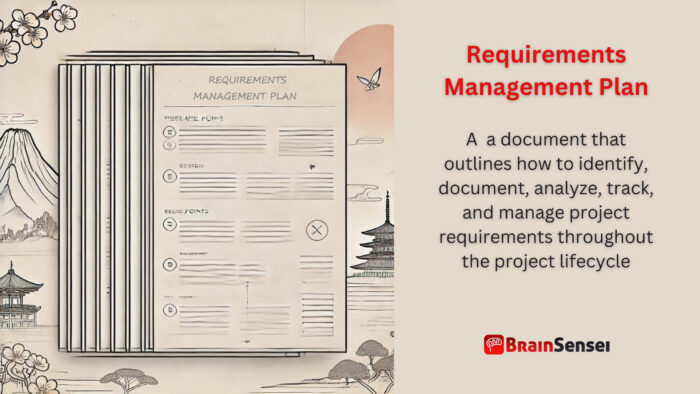
Requirements Management Plan
What is a Requirements Management Plan?
A requirements management plan is a document that outlines how to identify, document, analyze, track, and manage project requirements throughout the project lifecycle. It ensures all requirements align with project goals and stakeholder expectations while providing a systematic approach to managing changes.
Key Takeaways
- Defines processes for requirement collection, documentation, and validation
- Establishes roles and responsibilities for managing requirements
- Provides guidelines for tracking and controlling requirement changes
- Ensures alignment between project deliverables and stakeholder needs
- Helps mitigate risks associated with mismanaged requirements
Understanding the Requirements Management Plan
How It Works
A Requirements Management Plan details the processes and tools to manage project requirements. It typically includes information about requirement-gathering techniques, documentation tools, validation procedures, and methods for tracking changes.
- Requirement Identification: Describes methods like interviews, surveys, and workshops to gather requirements
- Requirement Documentation: Specifies formats, templates, and tools for recording requirements
- Requirement Analysis: Outlines techniques for analyzing requirements for feasibility, clarity, and consistency
- Requirement Tracking: Defines tools and processes for tracking requirements throughout the project lifecycle
- Requirement Change Management: Establishes protocols for handling changes to requirements, including change request evaluation and approval
Notes
- Involve stakeholders early in the requirement-gathering process to ensure clarity.
- Use requirement management tools like Jira, IBM Rational DOORS, or Confluence for better tracking.
- Regularly review and validate requirements to prevent scope creep.
- Document assumptions and constraints to provide context for requirements.
- Ensure clear communication protocols for requirement changes to avoid confusion.
Related Terms
Understanding a Requirements Management Plan requires familiarity with related project management concepts.
- Project Scope Management: Involves defining and controlling project scope to meet the project objectives
- Stakeholder Management: Focuses on identifying, engaging, and communicating with project stakeholders
- Change Management Plan: A framework for managing changes to project requirements, processes, or deliverables
- Business Requirements Document (BRD): A detailed document that captures business needs and high-level requirements
- Traceability Matrix: A tool that tracks requirements throughout the project lifecycle to ensure goal alignment
Examples of Requirements Management Plans
Manufacturing Industry
In a manufacturing project for a new production line, the Requirements Management Plan included detailed specifications for equipment, production processes, and quality standards. The business analysis team gathered requirements from production managers and technical staff through workshops. The plan defined how requirements would be documented in a digital repository, tracked through a traceability matrix, and updated following a structured change management process. They scheduled regular stakeholder meetings to review requirement changes, ensuring the final production line met operational goals. The project team also implemented automated tracking tools to monitor real-time updates and flag discrepancies promptly. The project conducted training sessions to familiarize team members with new requirements management protocols, leading to more efficient communication and fewer errors during implementation.
Furthermore, the manufacturing company faced challenges when suppliers introduced new technology standards midway through the project. The Requirements Management Plan helped the team systematically assess these changes, evaluate their impact on the project timeline and budget, and implement necessary adjustments without disrupting production schedules. The company successfully launched the new production line on time and within budget by maintaining thorough documentation and adhering to the established process.
Healthcare Industry
A healthcare IT project to develop a patient management system used a Requirements Management Plan to address regulatory and functional requirements. The plan outlined the process for collecting requirements from healthcare professionals, compliance officers, and IT staff. It included protocols for documenting requirements in a central database, validating them through stakeholder reviews, and handling change requests via formal approval. The plan helped ensure the system met both clinical needs and healthcare regulations. The plan integrated steps for compliance checks and audit trails to accommodate stringent healthcare data protection laws.
As the project progressed, unforeseen challenges arose, such as stakeholders’ varying interpretations of data access policies. The Requirements Management Plan provided a framework for resolving these differences through structured discussions and consensus-driven decision-making. The healthcare IT team also established a continuous feedback loop, allowing end-users to suggest improvements during system testing. This proactive approach enhanced the software’s functionality and built greater trust and satisfaction among medical staff.
Government Sector
The requirements management plan for a government infrastructure project specified methods for capturing requirements related to public safety, accessibility, and regulatory compliance. The team documented the requirements in a centralized system, assigning clear roles for approval and tracking. The plan defined how requirement changes would be evaluated for their impact on costs and timelines, helping maintain project transparency and accountability. The team implemented comprehensive communication to convey updates to all relevant departments.
During the project’s execution phase, external regulatory agencies introduced new safety guidelines that required immediate attention. The Requirements Management Plan facilitated the prompt incorporation of these guidelines by outlining predefined procedures for assessing regulatory changes. The project team held emergency review sessions to prioritize the necessary adjustments, demonstrating the plan’s adaptability to evolving requirements. Additionally, they conducted post-implementation evaluations to gather insights and identify opportunities for refining requirement management practices in future projects.
These examples illustrate how a well-structured Requirements Management Plan can enhance project outcomes across diverse industries by providing clarity, consistency, and flexibility in managing project requirements.
Use Cases of Requirements Management Plan
United States (Construction Industry)
A construction company in Texas developed a Requirements Management Plan for a commercial building project. The plan included processes for gathering requirements from architects, contractors, and clients. Using a traceability matrix, the project team tracked requirements from design through construction. Regular stakeholder meetings ensured that any changes to building specifications were assessed and approved through a defined process. This approach minimized rework, reduced costs, and ensured client satisfaction. The team conducted regular training sessions to ensure all members understood the importance of requirement tracking. Additionally, they integrated new software tools to automate change requests, reducing manual errors.
Throughout the project, the team faced challenges such as discrepancies between architectural drawings and client expectations. The Requirements Management Plan enabled the project team to reconcile these differences by involving clients in regular review sessions. This proactive approach ensured the final building design aligned with client needs and avoided costly post-construction modifications.
Germany (Transportation Industry)
A railway infrastructure project in Germany utilized a Requirements Management Plan to manage requirements for new signalling systems—the plan detailed techniques for gathering requirements from engineers, government regulators, and transportation officials. A centralized software tool tracked requirement changes. A formal process ensured the inclusion of regulatory requirements. As a result, the signalling system met operational and legal standards without delays. The plan also included contingency protocols for managing last-minute regulatory updates.
New European Union safety standards were introduced midway through the project, posing a significant risk to the timeline. The Requirements Management Plan facilitated the rapid assessment and integration of these standards without affecting the delivery schedule. The team organized workshops to train staff on the updated requirements and adjusted project plans accordingly. The project achieved full regulatory compliance by maintaining a robust requirements management framework and completed the installation within the projected timeline.
India (Telecommunications Industry)
A telecommunications provider in India implemented a Requirements Management Plan to launch a 5G network. The plan outlined methods for collecting technical and customer service requirements from engineers. The team documented the criteria in a database with clear guidelines for evaluating and approving changes. The structured approach helped the company roll out its 5G network on schedule while meeting performance goals.
As the project progressed, the company faced challenges related to infrastructure compatibility across different regions. The Requirements Management Plan included a risk management component that allowed the team to identify potential issues early. Collaborations with local governments helped streamline permitting processes and avoid delays. Additionally, the engineers integrated customer feedback mechanisms to gather insights on network performance. The company’s systematic approach enabled deploying a high-quality, reliable 5G network across multiple states.
By following a structured Requirements Management Plan, these organizations successfully navigated challenges, ensured stakeholder satisfaction, and delivered high-quality outcomes.
Best Practices for Requirements Management Plans
A Requirements Management Plan is essential for project success, but missteps can lead to scope creep, miscommunication, and unmet objectives. Best practices include:
Engage Stakeholders Early
Gather comprehensive requirements by involving key stakeholders from the outset. This approach will ensure the requirements are accurate, complete, and aligned with project goals. Early engagement will foster better communication and build trust among stakeholders.
Use a Traceability Matrix
Track requirements from inception through delivery to maintain alignment with project goals. The matrix helps identify dependencies, detect inconsistencies, and provide a clear audit trail.
Implement Clear Change Management Processes
Establish protocols for evaluating and approving changes to prevent uncontrolled scope changes. A robust change management process assesses changes that impact the project timeline, cost, and quality before approval.
Regularly Review Requirements
Schedule periodic reviews to ensure requirements remain relevant and accurate. Regular reviews also help adapt to changes in project scope, technology, or market conditions.
Leverage Requirements Management Tools
Use software platforms like IBM Rational DOORS, Jama Connect, or Jira to manage requirements efficiently. Modern tools offer collaborative features, automated tracking, and real-time reporting.
Train the Project Team
Provide project team members with training on requirements management processes and tools. Practical training ensures consistent adherence to the plan and minimizes errors.
Communicate Effectively
Maintain open, transparent communication channels among project stakeholders. Clear communication reduces misunderstandings and promotes better collaboration.
Document Assumptions and Constraints
Record all assumptions and constraints during requirement collection. Documentation helps provide context, avoid misunderstandings, and guide decision-making throughout the project.
Conduct Requirement Validation and Verification
Implement processes to validate requirements with stakeholders and verify them against project objectives. Validation ensures requirements meet stakeholder needs, while verification confirms technical feasibility.
Establish Performance Metrics
Define key performance indicators (KPIs) for requirements management activities. Metrics such as requirement stability, change request rates, and stakeholder satisfaction can help assess the plan’s effectiveness.
By adopting these best practices, project teams can enhance requirement clarity, streamline change management, and improve project outcomes.
Common Mistakes and Issues
Managing project requirements effectively requires adherence to best practices. Common mistakes in requirements management include:
Inadequate Stakeholder Engagement
Failure to involve stakeholders early can result in incomplete or misunderstood requirements. For instance, a financial institution developing new software once excluded its compliance team, leading to costly revisions.
Unclear Requirement Documentation
Vague or ambiguous requirements can lead to misaligned deliverables. Standardized templates and clear documentation protocols help mitigate this risk.
Neglecting Change Management Processes
Projects that lack formal change management will likely experience uncontrolled scope creep. Establishing clear guidelines for evaluating and approving changes ensures better project control.
Inconsistent Requirement Reviews
Review the requirements regularly to keep them current and relevant. Implementing scheduled review cycles keeps requirements aligned with project objectives.
Poor Communication Practices
Miscommunication between teams can cause critical misunderstandings. Regular meetings, clear documentation, and accessible communication channels help prevent these issues.
Learning from these mistakes and implementing proactive strategies helps maintain clarity and project success.
Frequently Asked Questions (FAQs)
What is the primary purpose of a Requirements Management Plan?
The Requirements Management Plan defines processes for managing project requirements to achieve the project goals and satisfy stakeholder needs.
How does a Requirements Management Plan help prevent scope creep?
The plan outlines clear procedures for tracking and managing requirement changes, ensuring that scope changes are evaluated and approved before implementation.
What tools do projects use to manage requirements?
Jira, IBM Rational DOORS, Jama Connect, and Confluence are popular tools for documenting, tracking, and validating requirements.
Who is responsible for a Requirements Management Plan?
Project managers, business analysts, and requirement management specialists typically collaborate on developing and maintaining the plan.
How often should requirements be reviewed?
Requirements should be reviewed regularly, especially at key project milestones, to ensure they remain aligned with project objectives.
Additional Resources
Preparing for a PMI certification?
- Exam Prep Courses: PMP®, CAPM®, and PMI-ACP®
- Exam Simulators: PMP®, CAPM®, PMI-ACP®, PMI-PBA®, PMI-RMP®, PMI-SP®, PgMP®, and PfMP®
- Professional Development Units (PDUs): 15, 30, and 60 PDU Bundles



